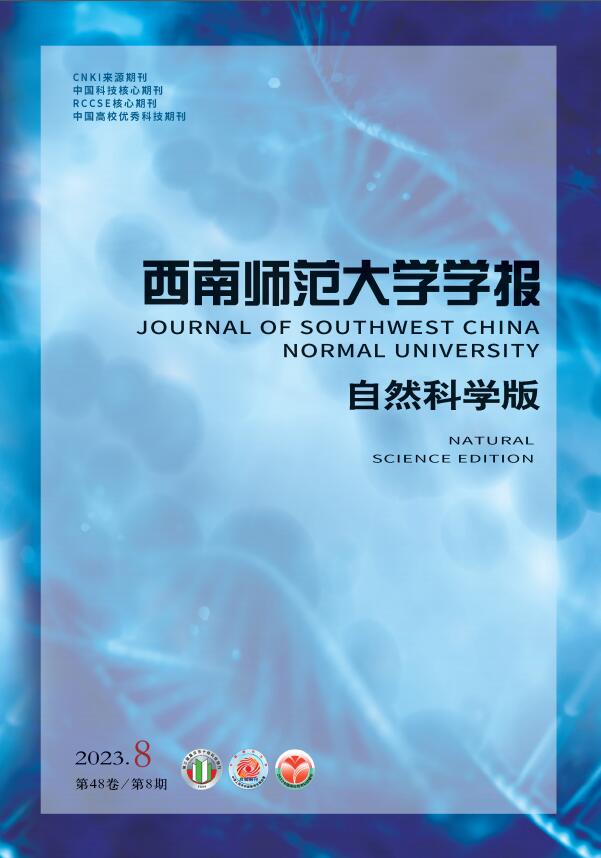-
本文所涉及的群皆为有限群. 利用非正规子群去研究群的性质和结构是有限群研究的一个重要方向. 例如:群G的非正规子群的个数为0,则G为Dedekind群,关于它结构的研究可参见文献[1]. 文献[2]利用有限单群分类定理证明了:如果有限非可解群G恰有2个非正规极大子群同阶类,那么
其中S(G)表示G的极大可解正规子群. 文献[3]研究了U(G)=1时群G的结构,其中U(G)表示群G的非正规子群的共轭类数. 文献[4]给出了幂零群G的幂零类c(G)和U(G)之间的一个关系式. 文献[5]研究了奇阶幂零群G的群结构,并给出了U*(G)和c(G)之间的一个关系式,其中U*(G)表示群G的非正规循环子群的共轭类数. 文献[6]给出了幂零群G的幂零类c(G)和U*(G)之间的一个关系式.文献[7]证明了:若G是非幂零群,J(G)=1当且仅当G=[N]P是裂扩张,其中N是G的正规子群,且阶是素数q,P是素数幂阶的循环p-群,且[N,Φ(P)]=1,素数p < q. 本文将继续这一研究,考虑J(G)=2的情形,得到了群G的结构分类.
记π(G)为群G的阶的所有素因子的集合,J(G)为群G的非正规子群阶的个数. 设G是可解群,
如果对任意的i,j都满足
那么称S={Gp1,…,Gps}为G的一个Sylow系. 群G是Dedekind群表示它的每个子群都是正规子群. 非交换的Dedekind群叫做Hamilton群.
引理1 设G是群,如果J(G)≤4,则G是可解群.
证 若G非可解,设M/N是G的非可解主因子,
其中S1,…,Sk是彼此同构的非交换单群,则
矛盾,于是G是可解群.
引理2[8] 设π′-群H作用在交换π-群G上,则G=CG(H)×[G,H].
引理3 设G是非幂零群,J(G)=2,则π(G)≤3.
证 若π(G)>3,设Pi是G的Sylow pi-子群(i=1,2,…,k,k≥4). 由G非幂零,不妨设G的Sylow p1-子群P1是G的非正规子群. 若P2
$\not \unlhd$ G,由J(G)=2,有P1P2,P1P3在G中正规,从而矛盾. 故G的所有Sylow子群中只有Sylow p1-子群是G的非正规子群. 由J(G)=2,P1
$\not \unlhd$ G,有P1P2,P1P3,P1P4中至少有2个子群在G中正规,不妨设P1P2,P1P3在G中正规,于是P1$\unlhd$ G,矛盾. 因此,π(G)≤3.定理1 设G是非幂零群,π(G)=3,J(G)=2,则
其中p,q,r为互异素数,m,k为正整数,且(k,p)=1.
证 设|G|=p1α1p2α2p3α3,由引理1,G是可解群,则G中存在Sylow系S={P1,P2,P3},其中Pi∈Sylpi(G),i=1,2,3. 由G非幂零,不妨设G的Sylow p1-子群P1是G的非正规子群.
若P1P2,P1P3都在G中正规,则
矛盾. 由
有P1P2,P1P3中必有一个子群是G的非正规子群. 不妨设P1P2
$\not \unlhd$ G,于是P2,P3,P1P3都在G中正规,从而若P1有两个不同的极大子群M1,M2,由J(G)=2,有
又由P1=〈M1,M2〉得P1
$\unlhd$ G,矛盾于P1$\not \unlhd$ G,于是P1只有一个极大子群,从而P1为循环群. 若α2>1,设N是P2的极大子群,则P1N=P1×N,又由P1N$\unlhd$ G得P1$\unlhd$ G,矛盾,于是α2=1,即P2为p2阶循环群.设K1,K2是P3中的两个不同的p3阶子群,则P1K1
$\unlhd$ G,P1K2$\unlhd$ G,又由P1=P1K1∩P1K2得P1$\unlhd$ G,矛盾. 于是P3只有唯一的p3阶子群,从而P3为循环群或者广义四元数群. 若P3是广义四元数群,由P3中每一个子群都在P3中正规,有P3$ \cong $ Q8,即P3为8阶的四元数群. 又由[P1,P3]≠1知,P3中存在4阶循环群在G中非正规,矛盾于J(G)=2,故P3为循环群.设H是P3的真子群,则H
$\unlhd$ P3. 考虑P1互素作用在P3上,有于是
故
因此
即P3为p3阶循环群.
综上所述,
其中p,q,r为互异素数,m,k为正整数,且(k,p)=1.
定理2 设G是非幂零群,π(G)=2,J(G)=2,则下述之一成立:
(a) G=〈x〉
$\ltimes$ 〈y〉,xpm=yq=1,pm≥p2,[x,yp2]=1,[x,yp]≠1;(b) G=(〈x1〉×〈x2〉)
$\ltimes$ 〈y〉,x1p=x2p=yq=1,[x2,y]∈〈y〉,[x1,y]=yk,(k,q)=1;(c) G=(〈x1〉×〈x2〉)
$\ltimes$ 〈y〉,x1pm=x2p=yq=1,pm≥p2,[x1p,y]=[x2,y]=1;(d) G=Q8
$\ltimes$ Cq;(e) G=〈y〉
$\ltimes$ 〈x〉,[y,x]∉ 〈y〉,ypm=xq2=1,[yp,x]=1;(f) G=〈y〉
$\ltimes$ (〈x1〉×〈x2〉),ypm=xiq=1,[yp,xi]=1,[y,xi]=xiki,(ki,q)=1,i=1,2;(g) G=〈y〉
$\ltimes$ (〈x1〉×〈x2〉),ypm=xiq=1,[yp,xi]=1,[y,xi]∉ 〈xi〉,i=1,2.其中p,q是互异素数,m,k1,k2为正整数.
证 设|G|=paqb,由G非幂零,不妨设G的Sylow p-子群P是G的非正规子群,即P
$\not \unlhd$ G. 设Q为G的Sylow q-子群. 我们分下面几种情形来讨论:情形1 M
$\not \unlhd$ G,1 < M < P.由M的所有真子群都在G中正规知,M只有一个极大子群,故M是循环群. 由J(G)=2得Q
$\unlhd$ G,且对G/Q的任意子群H/Q都满足H/Q$\unlhd$ G/Q,于是G/Q为Dedekind群. 同理G/N也是Dedekind群,其中N是Q的非平凡子群.下面证明Q是循环群. 设
则PN1
$\unlhd$ G,PN2$\unlhd$ G,于是P$\unlhd$ G,矛盾. 故Q只有一个q阶子群,因此Q是循环群或者是广义四元素群. 若Q是广义四元素群,则由Q中每一个子群都在Q中正规得Q$ \cong $ Q8. 又由[P,Q]≠1知,Q中存在4阶循环群是G的非正规子群,矛盾.故Q是循环群.若b>1,设N是Q的q阶子群,则N
$\unlhd$ G,于是其中g∈P. 考虑〈g〉互素作用在Q上,有
于是[〈g〉,Q]=1,Q. 若[〈g〉,Q]=Q,则与N是Q的真子群矛盾,于是
由J(G)=2,有〈g〉×N
$\unlhd$ G,于是〈g〉$\unlhd$ G. 又由g的任意性得P$\unlhd$ G,矛盾,故Q为q阶循环群. 设Q=〈y〉,yq=1.下面探究P的结构. 由P
$ \cong $ G/Q得P也是Dedekind群. 我们分为两种情形:情形1.1 P是交换群,则P/M为循环群.
如果P/M不是循环群,设
则P中存在两个不同的子群M1,M2,使得
由
以及M的极大性得M=M1∩M2. 又由M1
$\unlhd$ G,M2$\unlhd$ G得M$\unlhd$ G,矛盾.如果M≤Φ(P),则P为循环群,设P=〈x〉. 显然,M为P的极大子群,否则M
$\unlhd$ G. 因此G=〈y〉$\rtimes$ 〈x〉,其中即G为(a)型群.
如果M
$\not \le $ Φ(P),取P中子群P1使得M是P1的极大子群,于是P=M×〈b〉,其中|b|=p. 若P1≠P,由P1$\unlhd$ G得[P1,Q]=1,于是[M,Q]=1,矛盾于M$\not \unlhd$ G,故P1=P. 若|M|=p,由M是P的极大子群,有|P|=p2,于是P的型不变量为(p2)和(p,p). 若P的型不变量为(p2),与M$\not \le $ Φ(P)矛盾,故P的型不变量为(p,p),即G为(b)型群. 若|M|≥p2,由J(G)=2,M$\not \unlhd$ G,有〈b〉$\unlhd$ G,故[〈b〉,Q]=1,即G为(c)型群.情形1.2 P是非交换群.
由P
$ \cong $ G/Q得P是Hamilton群,于是P=Q8×C2n,其中n是正整数.如果P/M是交换群,则P/M是循环群. 若否,设
则P中存在两个不同的子群M1,M2,使得
由
以及M的极大性得M=M1∩M2. 又由M1
$\unlhd$ G,M2$\unlhd$ G得M$\unlhd$ G,矛盾. 因M循环,故P=〈x,y〉$ \cong $ Q8,于是G=Cq$\rtimes$ Q8,即G为(d)型群.如果P/M是非交换群,则P/M是Hamilton群. 令P1=P′×M,于是
故M
$\unlhd$ G,矛盾. 因此,这类群不存在.情形2 设G的非正规子群为H,(|H|,|Q|)≠1.
若Q
$\not \unlhd$ G,不妨设p>q,显然P,Q都是循环群,于是P$\unlhd$ G,矛盾,故Q$\unlhd$ G. 由J(G)=2,P$\not \unlhd$ G得P只有一个极大子群,故P为循环群,设P=〈y〉.情形2.1 Q是交换群.
考虑P互素作用在Q上,有Q=CQ(P)×[P,Q],故
若|CQ(P)|> q,由
得〈P,x〉
$\not \unlhd$ G,其中x∈CQ(P),故至少可以构造出2个不同阶的G的非正规子群,与J(G)=2矛盾. 若|CQ(P)|=q,设CQ(P)=〈x〉,其中xq=1. 由P$\not \unlhd$ G,P×〈x〉$\not \unlhd$ G知,G的其他阶子群均正规于G,于是存在x1∈[P,Q]且|x1|=q,使得〈x1〉$\unlhd$ G,故[P,〈x1〉]=〈x1〉. 又由有〈xx1〉
$\not \unlhd$ G,与J(G)=2矛盾,于是考虑Ω1(Q). 若Ω1(Q)≠Q,则
于是PΩ1(Q)
$\not \unlhd$ G,故对∀x∈Ω1(Q),有〈x〉$\unlhd$ G. 又由有P〈x〉
$\not \unlhd$ G,故P〈x〉=PΩ1(Q),因此Q只能是循环群,且|Q|=q2,[〈yp〉,Q]=1. 设Q=〈x〉,xq2=1,即G为(e)型群. 若Ω1(Q)=Q,则Q为初等交换q-群.若存在x∈Q,使得〈x〉
$\unlhd$ G,则P〈x〉$\not \unlhd$ G,故Q的子群均正规于G. 由Q=[Q,P]得|Q|=q2,于是又由P的极大子群都是G的正规子群得[〈yp〉,Q]=1,p|q-1,即G为(f)型群.
若对∀x∈Q有〈x 〉
$\not \unlhd$ G,则Q中所有阶大于1的真子群都是G的非正规子群,于是Q是q2阶的初等交换q-群,因此即G为(g)型群.
情形2.2 Q是非交换群
若对∀H≤Q有H
$\unlhd$ G,则Q$ \cong $ Q8×C2n,其中n是正整数,于是Q′≤Z(G),P×Q′$\not \unlhd$ G,故对∀x∈Q有〈x〉$\unlhd$ G. 又由x4=1得[P,〈x〉]=1,于是[P,Q]=1,矛盾. 因此,这类群不存在.若存在H≤Q使得H
$\not \unlhd$ G. 设N≤Z(Q),且N是G的极小正规子群,则由
得N=CN(P)或N=[N,P]. 若N=CN(P),则PN=P×N
$\unlhd$ G,于是P$\unlhd$ G,矛盾,故N=[N,P]. 取x∈Q\N且xq∈N,则M=〈x,N〉是交换群. 由G/N=PN/N×Q/N得[M,P]≤N. 又由得M=CM(P)×N,故|CM(P)|=q. 考虑PCM(P),由
得P
$\unlhd$ G,矛盾. 因此,这类群不存在.
Finite Groups with the Number of Non-Normal Subgroups of Order 2
- Received Date: 03/03/2022
- Available Online: 20/10/2022
-
Key words:
- non-normal subgroup /
- solvable group /
- nilpotent group
Abstract: The numerical properties of the non-normal subgroups of a finite group have an important influence on the structure of a finite group. In this paper, let J(G) denote the number of non-normal subgroups orders of finite group G, the structure of finite group G with J(G)=2 has been discussed and the classification of the finite group been given.






 DownLoad:
DownLoad: